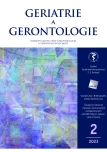How about leg ulcers? Local treatment of lower leg ulcers of venous etiology with Negative pressure wound therapy
Authors:
Koutná Markéta; Blechová Kamila; Šaková Rita
Authors‘ workplace:
Geriatrická klinika 1. lékařské fakulty Univerzity Karlovy a Všeobecné fakultní nemocnice v Praze
Published in:
Geriatrie a Gerontologie 2023, 12, č. 2: 88-93
Category:
Review Article
Overview
Negative pressure therapy (Negative pressure wound therapy, Vacuum Assisted Closure, Topical negative pressure, etc.) has been used in the treatment of complicated and non-healing wounds in the Czech Republic for more than 20 years. Initially, the indication for „negative pressure“ was more used for extensive complicated surgical wounds, post-traumatic wounds, pressure ulcers of the 3rd and 4th degree or to solve defects in diabetic foot syndrome. With the development of device technology, including the offer of disposable devices, negative pressure therapy is also used for less complicated wounds. However, the treatment of lower limb ulcerations of venous etiology is less commonly used. In the wound healing clinic at the Geriatric Clinic (General University Hospital in Prague 2), patients with venous insufficiency limb ulcers account for more than 70 % of all etiologies. Treatment of extensive defects with the use of therapeutic agents can take several years. The use of negative pressure therapy has become another option to speed up the healing of defects. The paper presents questions that must be solved individually for each patient during negative pressure therapy. We demonstrate the development and results of treatment with the use of wound healing agents and negative pressure therapy on case study of a patient with a diagnosis of leg ulceration of venous etiology.
Keywords:
negative pressure wound therapy – leg ulcer – NPWT – ulceration – venous etiology
Sources
1. Kieser DC, Roake JA, Hammond C. Negative pressure wound therapy as an adjunct to compression for healing chronic venous ulcers. J Wound Care [online]. 2011; 20(1): 35–37 [cit. 2023-04-22].
2. Walczak DA, Wojtyniak M, Jaguścik R, et al. Management of large chronic venous leg ulcers with negative pressure wound therapy. Negative Pressure Wound Therapy Journal 2017; 4(2): 17–22.
3. Arvesen K, Nielsen CB, Fogh K. Accelerated wound healing with combined NPWT and IPC: a case series. Br J Community Nurs 2017; 22: (Suppl. 3): S41–S45.
4. Hampton J. Providing cost- -effective treatment of hard-to- -heal wounds in the community through use of NPWT. Br J Community Nurs 2015; Suppl Community Wound Care: S14, S16–20.
5. Dowsett C, Grothier L, Henderson V, et al. Venous leg ulcer management: single use negative pressure wound therapy. Br J Community Nurs 2013; Suppl. S6: S8–10, S12–15.
6. Khashram M, Huggan P, Ikram R, et al. Effect of TNP on the microbiology of venous leg ulcers: a pilot study. J Wound Care [online] 2009; 18(4): 164–167 [cit. 2023- 04-27].
7. Davies CE, Hill KE, Newcombe RG, et al. A prospective study of the microbiology of chronic venous leg ulcers to reevaluate the clinical predictive value of tissue biopsies and swabs. Wound Repair [online] 2007; 15(1): 17–22 [cit. 2023-04-27].
8. Andrews A, Upton D. Negative pressure wound therapy: improving the patient experience part 3 of 3. J Wound Care 2013; 22(12): 671–2, 674, 676–8 passim.
9. Vowden P. Ten Top Tips... Using negative pressure wound therapy effectively. Wounds International [online] 2014; 5(2): 13–15 [cit. 2023-04-28].
10. Jeffery S. The use of an antimicrobial primary wound contact layer as liner and filler with NPWT. J Wound Care 2018; 23(Suppl. 8): S3–S14.
11. Bateman S D. Evidence is building to support using a DACC-coated antimicrobial wound contact layer with NPWT. Wounds–UK [online] 2015; 11(1): 82–85 [cit. 2023-05- 02].
12. Stryja J, a kol. Repetorium hojení ran 2. Semily: Geum, 2014: 325.
13. Yukie M, Nakagami G, Kitamura A, et al. Effectiveness of biofilm-based wound care system on wound healing in chronic wounds. Wound Repair [online] 2019; 27(5); 540– 547 [cit. 2023-04-28].
14. Zonghuan L, Aixi Y. Complications of negative pressure wound therapy: A mini review. Wound Repair [online] 2014; 22(4): 457– 461 [cit. 2023-04-28].
15. Roberts Ch, Lewis N, Leaper D. Development of a UK cost analysis model for the various methods of debriding leg ulcers. Wounds UK [online] 2019; 15(2): 54–60 [cit. 2023-04-28].
16. Kucharzewski M, Mieszczanski P, Wilemska-Kucharzewska K, et al. The application of negative pressure wound therapy in the treatment of chronic venous leg ulceration: authors experience. BioMed Research International [online] 2014; 297230- 297230 [cit. 2023-04-29].
17. Malone M, Swanson T. Biofilmbased wound care: the importance of debridement in biofilm treatment strategies. Br J Community Nurs [online] 2017; 22: S20 [cit. 2023-04-29].
18. Vuerstaek J D, Vainas T, Wuite J, et al. State-of-the-art treatment of chronic leg ulcers: A randomized controlled trial comparing vacuum- assisted closure (V.A.C.) with modern wound dressings. J Vasc Surg 2006; 44(5): 1029–1037.
19. Dowsett C. Recommendations for the use of negative pressure wound therapy. Wounds UK 2012; 8(2): 48–59.
20. Back DA, Scheuermann-Poley C, Willy C. Recommendations on negative pressure wound therapy with instillation and antimicrobial solutions – when, where and how to use: what does the evidence show? Int Wound J 2013; 10(Suppl. 1): 32–42.
21. Gefen A. The influence zone: a critical performance measure for negative pressure wound therapy systems. Br J Nurs 2022; 31(15): S8–S12.
Labels
Geriatrics General practitioner for adults Orthopaedic prostheticsArticle was published in
Geriatrics and Gerontology

2023 Issue 2
Most read in this issue
- Presbyphagia versus dysphagia – the role of the speech therapist in the management of swallowing disorders
- Frailty – prevalence of acutely hospitalized seniors from 1995 to 2022
- Mental and physical condition of patients in postacute hospital care – analysis of the results of a Czech literature review
- Results of surgical treatment of proximal femur fractures in patients operated at the Traumatology Clinic of the University Hospital Olomouc in the years 2017–2021
